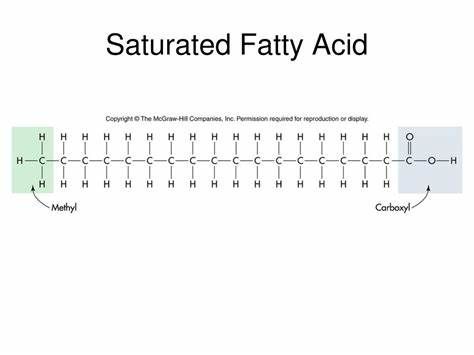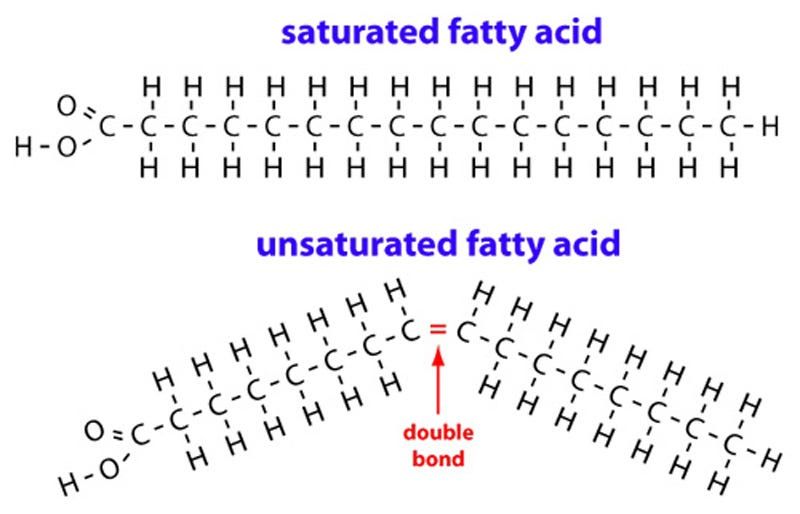What Are Fatty Acids?
Fatty acids are the building blocks of fats and oils. They are long chains made mostly of carbon (C) and hydrogen (H) atoms, ending with a special group called a carboxylic acid group (-COOH). These chains can be straight or bent, depending on the type of bonds between the carbon atoms.
Fatty acids are a major part of the fats we eat in our diet, and they also play key roles in our bodies—such as storing energy, insulating organs, and helping with cell membrane structure.
Fatty acids are generally classified into two major types:
- Saturated Fatty Acids
- Unsaturated Fatty Acids
Table of Contents
1. What Are Saturated Fatty Acids?
A saturated fatty acid is a type of fatty acid in which all carbon atoms are connected by single bonds. There are no double bonds in the carbon chain.

Imagine a long train where each carriage (carbon atom) is holding hands with two hydrogen atoms. There are no spaces left for more hydrogen; the chain is fully “saturated” with hydrogen atoms.
Structure:
- All carbon atoms are joined by single bonds.
- The chain is straight, making it easy to pack tightly together.
Example:
- Palmitic acid
- Stearic acid
Common Sources:
- Animal fats (butter, cheese, meat fat)
- Palm oil
- Coconut oil
- Lard
2. What Are Unsaturated Fatty Acids?
Unsaturated fatty acids contain one or more double bonds between the carbon atoms in the chain. Because of these double bonds, the chain has “kinks” or bends, meaning it cannot pack tightly.
The double bond(s) reduce the number of hydrogen atoms in the chain, hence the term “unsaturated.”

There are two types of unsaturated fatty acids:
- Monounsaturated (one double bond)
- Polyunsaturated (more than one double bond)
Structure:
- Contains at least one double bond.
- The presence of double bonds causes bends or kinks in the chain.
Examples:
- Oleic acid (monounsaturated)
- Linoleic acid and Alpha-linolenic acid (polyunsaturated)
Common Sources:
- Olive oil
- Nuts and seeds
- Avocados
- Fatty fish (like salmon, mackerel)
- Sunflower oil
Side-by-Side Comparison

| Feature | Saturated Fatty Acids | Unsaturated Fatty Acids |
|---|---|---|
| Bond Type | Only single bonds | One or more double bonds |
| Hydrogen Saturation | Fully saturated | Not fully saturated |
| Shape | Straight chain | Bent or kinked chain |
| State at Room Temp | Solid (e.g., butter) | Liquid (e.g., olive oil) |
| Source | Animal fats, dairy | Plants, fish, nuts |
| Health Effect | Can raise bad cholesterol (LDL) | Can lower bad cholesterol (LDL) and raise good cholesterol (HDL) |
| Examples | Stearic acid, Palmitic acid | Oleic acid, Linoleic acid |
| Storage in Body | Stored as body fat | Often used for cell function |
| Melting Point | High | Low |
Why Does the Structure Matter?
Structure plays a big role in how these fatty acids behave in your body.
Saturated Fatty Acids:
- The straight chains stack up closely, which is why they are solid at room temperature.
- Because they are tightly packed, they can stick to the inside of arteries, possibly leading to heart disease over time.
Unsaturated Fatty Acids:
- The bends caused by double bonds prevent tight packing, so they are usually liquid at room temperature.
- These fats tend to support heart health, reduce inflammation, and improve cholesterol levels.
Health Effects: Which One Is Better?
Let’s be clear: your body needs both types of fatty acids. However, too much of saturated fats can be harmful in the long run.
Saturated Fats:
- Can increase LDL cholesterol (bad cholesterol)
- May raise risk of heart disease, stroke, and clogged arteries
- Found in processed foods, fried items, and fatty cuts of meat
Unsaturated Fats:
- Increase HDL cholesterol (good cholesterol)
- Lower LDL cholesterol
- Improve heart function, reduce inflammation
- Essential for brain function and hormone production
Cooking Properties
Saturated Fats:
- More stable at high temperatures
- Less likely to oxidize or go rancid
- Good for frying or baking
Unsaturated Fats:
- More prone to oxidation
- Healthier but less stable at high heat
- Best used in salad dressings, low-heat cooking, or eaten raw (e.g., olive oil)
Role in the Human Body
Saturated Fatty Acids:
- Provide energy
- Help in hormone production
- Protect organs
However, excess can lead to:
- Obesity
- Heart disease
- Fatty liver
Unsaturated Fatty Acids:
- Help form cell membranes
- Aid brain development
- Reduce inflammation
- Improve blood circulation
Some unsaturated fatty acids (like omega-3 and omega-6) are essential, meaning your body cannot make them — you must get them from food.
Chemical Behavior
- Saturated fatty acids are more stable due to single bonds, less reactive with oxygen.
- Unsaturated fatty acids, due to double bonds, are more reactive and prone to oxidation (can go rancid faster).
Dietary Recommendations
Most health experts and nutritionists suggest:
- Limit saturated fat intake to less than 10% of total daily calories.
- Replace saturated fats with unsaturated fats wherever possible.
- Use oils like olive oil, canola oil, or fish oil instead of butter or ghee.
Trans Fats: The Dangerous Side
While we’re on the topic of fats, it’s important to mention trans fats.
- These are artificial fats made by hydrogenating unsaturated fats (adding hydrogen to make them solid).
- Found in margarine, baked goods, and fast foods.
- They raise LDL and lower HDL, making them the most harmful fats.
- Most health authorities strongly advise avoiding trans fats completely.
Summary in Simple Words:
| Category | Saturated Fats | Unsaturated Fats |
|---|---|---|
| Found In | Butter, cheese, meat | Olive oil, nuts, fish |
| Room Temp | Solid | Liquid |
| Health | Harmful in excess | Healthier option |
| Bonds | Single only | One or more double bonds |
| Shape | Straight | Bent |
| Usage | Cooking, baking | Salad, cooking oils |
| Effect on Cholesterol | Raises LDL (bad) | Raises HDL (good), lowers LDL |
How to Remember the Difference Easily?
Here’s a simple trick:
- Saturated = Solid (S for Solid, S for Saturated)
- Unsaturated = Unsolid (or Liquid)
Or visualize:
- Saturated = Straight and Stiff
- Unsaturated = Unstraight (bent) and flowing (liquid)
Conclusion
Fats are a vital part of our diet, but the type of fat we consume plays a huge role in our health.
- Saturated fats are important but should be eaten in moderation.
- Unsaturated fats are heart-friendly and should replace saturated fats wherever possible.
- Eating a balanced amount of healthy fats helps the body function smoothly from keeping your brain sharp to protecting your heart.
Final Thoughts for a Healthy Life:
- Cook with healthy oils (olive, canola, sunflower).
- Eat more nuts, seeds, and fatty fish.
- Limit butter, ghee, and red meat fat.
- Avoid trans fats completely.
- Balance is key don’t avoid fats entirely; just choose the right kind.
FREQUENTLY ASKED QUESTIONS
What is saturated fats?
Saturated fats are a type of fat found mostly in animal products and some oils, made of fatty acid chains with only single bonds, and are usually solid at room temperature.
What is unsaturated fats ?
Unsaturated fats are a type of fat made up of fatty acid chains that contain one or more double bonds between carbon atoms, which makes them less saturated with hydrogen and usually liquid at room temperature.
Which one is better, saturated or unsaturated fats ?
Unsaturated fats are better for your health than saturated fats because they help lower bad cholesterol and reduce the risk of heart disease.
Related Articles




